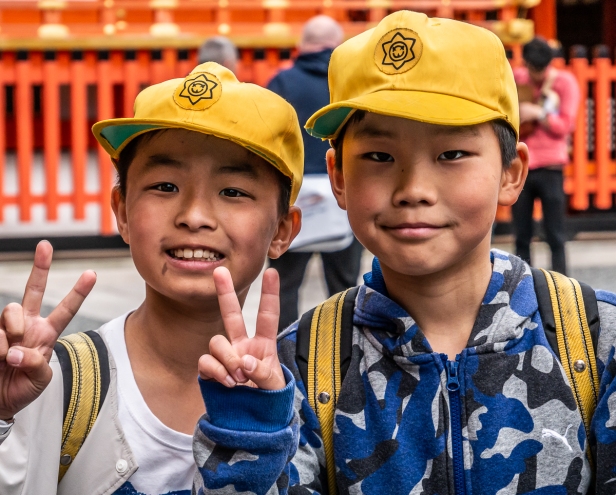
9-15 May 2018. In 1950 a disturbed 22-year-old novice monk burned down the five-hundred–year-old Rokuon-ji Temple in Kyoto, and then attempted suicide. He was arrested and imprisoned, but later released as mentally ill, suffering from schizophrenia and a persecution complex. He died in 1956 from tuberculosis.
The temple, originally a retirement home for Shōgun Ashikaga Yoshimitsu, was converted to a Zen Buddhist Temple upon his death in 1408 as per his instructions. In the ensuing years it was burned to the ground and rebuilt several times, including twice during the Onin (civil) war of 1467-77.
And then it was burned to the ground by the deranged monk. In 1955 it was rebuilt as a close replica of the original.
Today the temple is known as Kinkaku-ji, or the The Temple of the Golden Pavilion, and it is one of the most iconic sights of Kyoto, and one of the most popular sites in all Japan. It is designated as a National Special Historic Site, and is one of seventeen locations that make up the Historic Monuments of Ancient Kyoto, which are World Heritage Sites.
But enough with the history lesson and the official designations. Kinkaku-ji is one of the most beautiful buildings I have ever seen. The millions of milling tourists make no difference, and even having seen photos before hand, I am still not prepared for the shimmering splendour of it.
The top two floors are covered with gold leaf and the entire building is reflected in the pond in front of it giving double the beauty. The original pavilion was built during a period that greatly relied on visual excesses, but that was not the only reason for encasing the exterior of the building in gold leaf: gold was believed to mitigate and cleanse any negative energy or thoughts concerning death.
The pond itself has small islands with pine trees,
and the surrounding garden is the perfect serene enhancement to showcase this exquisitely simple and lovely building.
I photograph and stare, and then stare some more, filled with wonderment. Slowly I follow the path around,
coming on the far side to a different view of the building,
the pond, and the surrounding garden.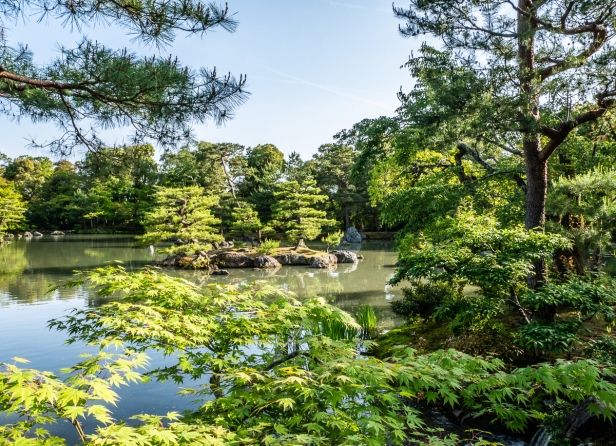

Finally I stroll through the garden, passing a small grotto with a waterfall,
and the sparse simplicity of the head priest’s former living quarters.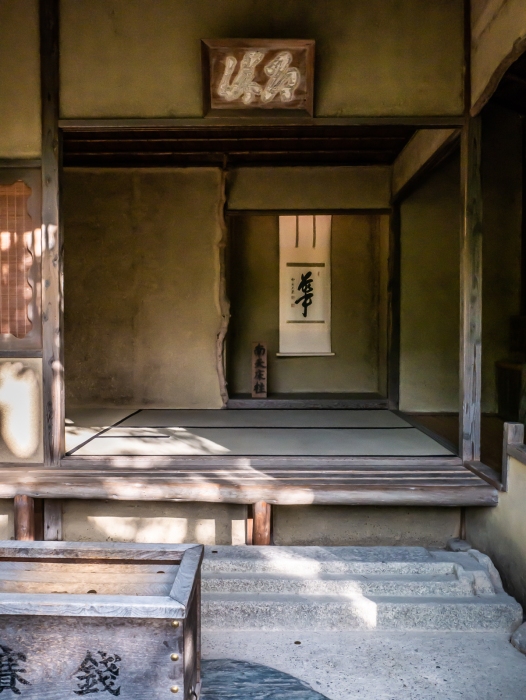
I think the young troubled monk did us all a favour. I looked at photos of the building that he burnt down. It had lost almost all of its gold leaf, to the point that it would be difficult for the ordinary viewer to ascertain that there had ever been any, and the old wooden building seemed ramshackle at best. The replacement, built in 1955 is a perfect little gem and an exquisite example of Japanese beauty.
************************************
For the first time ever I get up and go out without at least having a cup of tea beforehand! I want to get to the shrine early before the crowds and had hoped to wake at about 5.30 or 6. Instead I wake at 7, wash my face, dress, and race to the hostel’s café. It doesn’t open until 8 so I just leave. First I walk in the wrong direction to the station. I know which way to go, but not trusting myself I ask another tourist in the hostel lobby which way. I head off in the direction he tells me until I realise he thinks I mean Kyoto Station, when actually I mean the Keihan Line station in the opposite direction. Arrrrgh why don’t I trust what I already know?
Eventually I get to the station and get a train to the shrine. When I get off the train I see a couple of tourists coming towards me. Once again I ask which way to go. You’d think I’d just look at the map on my phone, but it’s so new to me it seems easier to ask people despite the arsehole in Tokyo. They give me directions but instead of turning right as they told me I turn left. Once again I’m walking in the wrong direction! Arrrrrgh!
Eventually I arrive at the main gate to the shrine. By now it’s 8.30 and I see that of course I haven’t beaten the crowds. I stop for coffee, which I just about inhale, and it’s about now that I suddenly see myself from the outside: all this striving and rushing all for the sake of getting the shot. I need that shot of all the red torii gates without any people in it. At least that’s what I’ve been telling myself. Spontaneously seeing myself from the outside I laugh and laugh. How silly we can be. I’d made it so important and caused myself so much stress that my head isn’t on straight, not to mention not trusting myself and going in the wrong direction not once but twice! Seeing myself from the outside breaks the spell. The laughter comes deep and naturally. I get present, slow down, and finally start to enjoy the day.
And I get the shot; the classic iconic shot of the red torii gates of Fushimi Inari-Taisha Shinto Shrine.
Fushimi Inari is the head shrine of thousands dedicated to the Shinto god Inari, the god of rice and of course also the god of sake, which is made from rice. To get a good rice harvest you need the right amount of rain, but the sun is also needed. The red of the torii gates represents the sun. As the importance of agriculture diminished the deity was enrolled to support business, since any business is also looking for a good “harvest”. Both good crops and success in business signify prosperity.
The main shrine, sitting at the base of the sacred Mount Inari, dates back to 1499.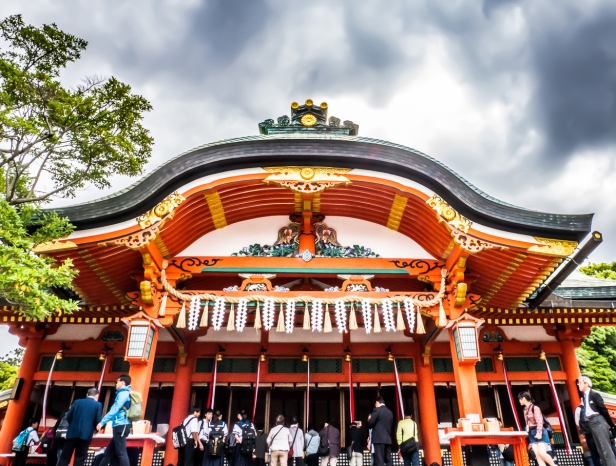
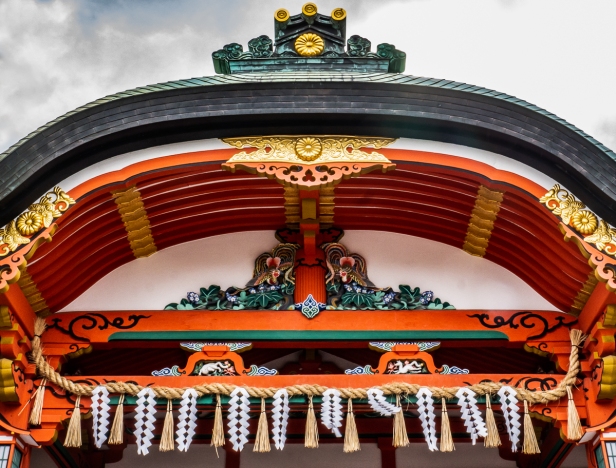

The entrance is through the imposing Rōmon Gate.
Beyond the main shrine there are dozens of smaller shrines scattered up the hillside reached by four kilometres of trails. This map
shows the trails and the location of the smaller shrines.
It also gives some idea of the number of torii gates there are spread all over the mountain at Fushimi Inari: more than 10,000!
The trails begin behind the shrine with the twin tunnels of gates known as Senbon Torii (or thousands of torii). This is the most photographed part of the shrine, and of course I want my own shots! Given the crowds I’m both astonished and thrilled that I get them. There are breaks in the crowds! It is the last thing I expected, but it is also often the outcome when you let go.
Here is the other side of the gates.
Each is inscribed with the name of the business that donated it in the hopes of receiving good fortune for their business, or in thanks because they already have. Most are from businesses, a few are from individuals – prayers for specific things, or thanks for receiving them.
Every gate is a prayer, or a thanksgiving.
Every now and then there is a gap just wide enough for me to squeeze through into the space between the twin tunnels. From the inside it is an infinite double row of hopes and dreams.
The practice of donating toriis started to spread since the 1600’s. The large gates start at 400,000 yen and go up to over one million yen (US$3,500-11,500). A torii was originally considered an opening to where god exists, hence the large stone torii at the entrance to all Shinto shrines. And hence all these scarlet torii at Fushimi Inari – the hope that each is a gate to the deity.
Beyond the densely packed torii of the twin tunnels, which you can see at the bottom right of the map, I come to the trail that goes up the mountain. I’ve not done my research so it’s a surprise. I find myself on a beautifully wooded trail.
I continue up past a bamboo forest,

past many smaller shrines, and past occasional gaps in the trees that give hints of the views to come.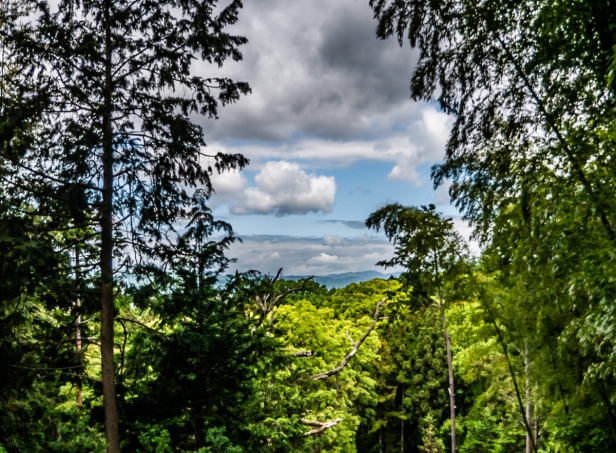
I don’t go to the top but instead go down a different trail back to the main shrine. Now I discover what the crowds are really like at the shrine, and it’s not even a weekend or holiday.
Apart from the many tourists there are hundreds of school children on a cultural excursion.



These young ones were tasked with questioning tourists to practice their English.
Leaving the shrine I walk down the pedestrian street I probably should have walked up to get to the shrine in the first place. It is a kaleidoscope of sights, sounds, aromas, and colours, and is packed with both people and street food stalls. Finally I eat – five delicious gyoza, and fresh squeezed orange juice. The oranges are put into a machine that bores a small hole in the top and then whizzes around inside the orange rendering it into juice. Unfortunately it only produces about three mouthfuls of juice. I tear the orange open and eat the rest of it. Desert is mango ice cream with a swirl of tofu soft ice cream on top. A fine way to break my fast although it is long past breakfast time.
Although I understand that if I want to get photographs with no, or few, people in them I have to arrive very early at major sites, I don’t mind the crowds. Everyone is there for the same reason. It’s because it’s a place that’s worth seeing. And this definitely proved to be true with Fushimi Inari and the Golden Pavilion.
Next post: The streets of Old Kyoto – Gion and Higashiama
All words and images by Alison Louise Armstrong unless otherwise noted
© Alison Louise Armstrong and Adventures in Wonderland – a pilgrimage of the heart, 2010-2018.

Stunning shots Alison!
LikeLiked by 1 person
Thanks Amanda. They’re both pretty stunning places that’s for sure.
Alison
LikeLike
Simply stunning.
LikeLiked by 1 person
Thanks Cindy.
Alison xo
LikeLike
Awesome photos! Thanks for sharing!
LikeLiked by 1 person
Thanks so much Liz. My pleasure!
Alison
LikeLiked by 1 person
They really are such beautiful works of art, aren’t they?
LikeLiked by 1 person
Oh yes Lorelle, they really are! I was completely captivated by both.
Alison
LikeLiked by 1 person
Ah, Alison – there’s so much beauty in this single post. It brought me right back to my own trip to Kyoto (and Bama’s first) two years ago. We went to Fushimi Inari around 4 in the afternoon, expecting massive crowds, but they were nowhere near the size of the ones you encountered after coming down the mountain! And I was also surprised at the breaks between streams of people going through the endless torii… we just had to stand and wait for everyone else to pass.
I think you found some gorgeous details that I missed at both Fushimi Inari and the Golden Pavilion; I don’t recall seeing the grotto with a waterfall or the former head priest’s living quarters. It’s hard to pick a favorite photo but if I really had to, I think I would choose the one of Fushimi Inari’s shrine office. It’s just so perfectly composed and I love both the elaborately decorated roofs and the dramatic sky above them.
LikeLiked by 1 person
Thank you so much James. I was astonished by the breaks in the crowds when trying to get my shots. But – I definitely had an advantage being as early as I was, even if it was not as early as I would have liked. The crowds were definitely worse after I came back down.
I *love* that photo of the shrine office! I was so pleased with it. I had no idea it would turn out so well. Definitely one of my favourites too.
Alison
LikeLiked by 1 person
Your post brings back so many memories! I loved the place, (the red Tori gates) but couldn’t stand that it was so full of people. No peace. No respite. Maybe, I too was too focused on getting ‘the shot’. But there were places in Kyoto that were so serene, I wondered what all the fuss was about.
LikeLiked by 1 person
I think the big draw for me to Fushimi Inari was seeing those red torii gates in person. I had no idea the shrine was on a mountain and that there were hiking trails behind it. There was some peace on the upper trail – very few people there, but for the rest of it I agree – very little peace there with the crowds. But I am glad I saw the toriis! No doubt I’d have been disappointed if I hadn’t been able to get the shots I wanted. I too found a couple of more peaceful places in Kyoto, but due to my own inner turmoil couldn’t take full advantage of them 😦
Alison
LikeLike
Wonderful travelogue as always, Alison. Those sweet children in their yellow hats!
LikeLiked by 1 person
Thanks so much Tish. Those little ones were so sweet. I watched them for a while. Unfortunately they didn’t pick me to ask questions of 😦
Alison
LikeLiked by 1 person
Beautiful. ❤️
LikeLiked by 1 person
Thanks Paulette. I found both places to be quite extraordinary.
Alison
LikeLike
what an amazing place of beauty
LikeLiked by 1 person
Yes, it really is. I’m so glad I went to Japan. Their aesthetic really appealed to me. Both the shrine and the temple were special experiences because they are so beautiful.
Alison
LikeLike
Both Kinkaku-ji and Fushimi Inari Shrine are among my favorite places in Kyoto. James and I even went to the former twice: first in the morning with some passing clouds, and then in the afternoon on the following day when the weather was even nicer. As for Fushimi Inari Shrine, I remember reading people’s blog posts mentioning about how much crowded it can get and how hard it is to take a clear shot of the vermilion torii gates. I came nonetheless, thinking that I would take some shots with a lot of people in them. But as James said, we were surprised that despite the endless stream of visitors, there were breaks long enough for us to snap some photos just with the torii in them.
LikeLiked by 1 person
They were both among my favourite places in Kyoto too. I didn’t go to as many shrines and temples as you two did, but I’m sure glad I picked these two. I’m also glad I got to Fushimi Inari as early as I did. I think the biggest crowds must be between about 10 and 3. There were great crowds of school children. It felt like just about every school in Kyoto had a class or two at the shrine that day! Anyway I got the shots I wanted, of both places, plus had some time to just enjoy them.
Alison
LikeLiked by 1 person
this beautiful Kyoto expression
really gets my Zen on 🙂
LikeLiked by 1 person
Thank you David.
Found my Zen
from time to time
but sometimes
too much rushing!
Trails behind the shrine
and the golden beauty
of Kinkaku-ji
were the Zen for me.
Alison
LikeLiked by 1 person
Fantastic photos – wonderful read! 🙂
LikeLiked by 1 person
Thanks so much Carsten. Glad you enjoyed it.
Alison
LikeLiked by 1 person
It is always a pleasure to read your traveling journals… and in combination with your wonderful photography any new post is a thrill, Alison! 🙂
LikeLiked by 1 person
I just called Mike over and told him he had to see this. First thing he said when he saw your photos of the Golden Shrine is “Is that real?”. It’s just so incredible…the lovely curves of the roof line, the serene pond, the shape of the trees growing out of the little rocky island, the luminous gold. We are both awestruck. Incredible photos Alison. Your iconic shot of the red gate is really amazing too. Thanks for bringing such beauty to our morning.
LikeLiked by 1 person
Thank you so much Caroline. My pleasure to share some beauty. I too was awestruck by the beauty of Kinkaku-ji. You can tell Mike yes it’s really real, though I certainly get how improbable it is.
I was so happy to get my shots of the torriis. 🙂
Alison
LikeLiked by 2 people
He’s very keen to go (thanks)!
LikeLiked by 2 people
You have captured some wonderful pictures here! It is a truly extraordinary place. One of the best places I have ever visited. You did well to get so many photos without the crowd sneaking in to the background! Lovely post!
LikeLiked by 1 person
Thank you so much David. One of the best places I’ve visited too. I think I was very lucky to get the shots I got. And very pleased.
Alison
LikeLiked by 1 person
Your honesty is disarming, and I guess that’s one of those lessons we keep re-learning, in different contexts. Your photos actually show the advantages of both views, with and without people. The gates without people are just gorgeous, compelling and slightly abstract. Then the kids! Fantastic! I love the two images with their leader taking their picture, and the one of a couple of kids running through the gates. I enjoyed the pond with its perfectly kept pine trees too, and the bamboo forest. I love the colorful map, too, thanks for including a photo of it. I hope all’s well with you, Alison!
LikeLiked by 1 person
Thanks so much Lynn. I was in such a tizzy about getting the shot that I forgot to be present and enjoy myself. It does seem to be a lesson I keep needing to learn. And I love it that always it seems as soon as I let go things unfold so beautifully – so then of course I got the shots I wanted, though I’m still amazed that I did.
The kids were fabulous! I’m glad I caught those ones running through the toriis – I’m fairly sure they were late and had to catch up to their class. And the teacher getting the class to pose – first the boys and then the girls. I love their uniforms.
I was a bit worried I had too many photos for this post, but in the end just put them all in because they all seemed to have something I wanted to say. I just couldn’t choose between the two of the bamboo forest!
All’s well with me here in Van. Loving the fall colours – it’s such a visually rich time of year. Hope all’s well with you too.
Alison
LikeLike
Awesome photos!
LikeLiked by 1 person
Thanks so much Linda. I got lucky with the gates that’s for sure.
Alison
LikeLike
Wonderful photos, thank you so much. Your trip is a visual treat and I think you’re so brave to tackle it solo. You give me hope that I might make such a trip in the future.
LikeLiked by 1 person
Thank you so much Chris. My pleasure! I think this trip solo really opened it up for me. I’m sure I’ll be more relaxed should I do future solo trips. You learn that you can do it. For when you do make your first solo trip I’d really recommend Japan – there’s plenty to see, the people are unfailingly polite and helpful, and it’s one of the safest countries in the world. I always felt completely safe alone, even at night.
Alison
LikeLike
Both of these places have been on my wish list for a while, and of course I’ve seen dozens of photos of them both. But as always, yours are special. You’ve captured the pavilion, in particular, from perspectives I’ve not seen as much, and seeing the nature surrounding it, the different sides, and the inside just add to my fascination with it. I had to laugh and nod at your working yourself up (and then catching yourself) for the photo opps – sounds like something I would do! Absolutely beautiful post; I’m even more enamored than I was before!
LikeLiked by 2 people
Thank you so much Lexie. I’d seen many photos of both places too, and really wanted to get my own. In the end it worked out. I wish I’d had more time to explore up the mountain at Fushimi. Better go back with Don 🙂
Japan blew me away. Still thinking about how amazing it is. You should go!
Alison
LikeLiked by 2 people
Nice article, I love Japanese history and I like the story of Kinkakuji. I think it has actually been destroyed twice.
LikeLiked by 2 people
Thank you so much. Oh yes, Kinkaku-ji has been burned and rebuilt several times, including twice during the Onin civil war, and then again by the monk in 1950. I did say that. Thanks for visiting!
Alison
LikeLiked by 1 person
The photos really convey it so well.
LikeLiked by 1 person
Thank you so much. It’s good to hear that.
Alison
LikeLiked by 1 person
Took a recent family vacation there with my wife and 4 small kids. Japan and it’s temples are amazing and fun for the whole family. Here’s a video of out 3 week trip there. https://m.youtube.com/watch?v=_lmyNpIzbvo
LikeLiked by 1 person
I agree – Japan is a wonderful destination and I can see how it would be great for families. It sounds like you had a great time.
Alison
LikeLike
Ah, interesting how another blogger sees the same place (Fushimi inari) in the same year as we did as well. 🙂
LikeLiked by 1 person
I think you were there just a few weeks after me. It was very hot the day I was there too (which I appreciated since I love hot weather). I’m so glad I went there. It’s a quite extraordinary place – and quintessentially Japanese.
Alison
LikeLiked by 1 person
The images you have captured are just mesmerizing, from the temple covered in gold leaf, to the red tori gates, to the bamboo forests. I don’t think I have seen so much beauty. Now I really want to go to Japan. Thanks so much for bringing it alive for us!
LikeLiked by 1 person
Thank you so much LuAnn. I was completely mesmerized by the beauty at these two places, and at many other places in Japan. It’s so much more than crowds and industrialization. The culture is strong, and the love of beauty integral to their way of being. I would love to go back. I hope you get there one day!
Alison
LikeLiked by 1 person
I am guessing that Don is sorry he missed this experience. What it must be like to live in such a place.
LikeLiked by 1 person
I think I will just have to go back to Japan and this time take Don with me 🙂
LikeLiked by 1 person
Beautiful selection of photos and commentary! I love the shots with the kids!
LikeLiked by 1 person
Thanks so much Michael. I’m glad you enjoyed it.
Alison
LikeLiked by 1 person
Your posts are always so beautifully written and photographed Alison. What a trip you had! Loving reading all your stories.
LikeLiked by 1 person
Thank you so much for your kind words Nicole. I’m so glad you’re enjoying the stories from Japan. It was an amazing trip. I’m really glad I went, even without Don.
Alison
LikeLike
so beautifully composed Alison…I’m revisiting…and also I’ve been to these spaces…and remember them…but you have created photographs that are strong…love the reds and gold and all those smiles ~ sending you joy ~ hedy ☺️❤️✌️
LikeLiked by 1 person
Thanks Hedy, I’m glad you like them. These were two of my fave places in Kyoto. Sending joy and smiles back to you rom rainy Vancouver xo ❤
Alison
LikeLiked by 1 person
Beautiful collection of pictures, Alison.
LikeLiked by 1 person
Thanks so much rabirius. Glad you like them!
Alison
LikeLike
Alison I’ve said this before but I must say that your ability to capture such well known tourist scenes in unique and original perspectives is very impressive. I’m also trying to take your lead and not let crowds get to me. Good point in that everyone if there to look at the same thing.
LikeLiked by 2 people
Thanks so much Sue. I guess I’m just curious so go in search of different ways of looking at things, and different views – like squeezing myself between the two rows of torii. I’m glad you like the photos. Sometimes the crowds bother me, but mostly not though it took me a while to be more accepting of them. And as I said the crowds almost always signify something worth seeing. I just wish I was more successful at getting up early!
Alison
LikeLiked by 2 people
Hi Alison
I enjoyed reading this; it reminds me of my trip to Kyoto and the Fushimi Inari Shrine last year. Seems ages ago.
I had to smile about your navigation problems. Although Google Maps is by no means foolproof, it tends to get me to the places where I want to go and is often more reliable than asking directions.. I get so confused by left and right and directions that include more than one instruction that my best bet is to carefully monitor and follow the little blue walking man on Google Maps. It has taken some practice, but I am now pretty confident using Google Maps wherever I go until, of course, the phone battery dies …
Lieve
LikeLiked by 2 people
Thanks Lieve, glad you enjoyed it. I actually had google maps, maps.me, and iMaps. I wasn’t short of map apps lol. maps.me is the only one that works without wifi, and I didn’t have data, but that was only part of the problem. It was the lack of practice with any of them, and my lack of confidence in using them. I did have a portable wifi device and one day in desperation turned it on to use google maps to find my hostel. To this day I don’t know why I didn’t use maps.me in that situation – which would have worked perfectly. Perhaps it was because maps.me didn’t have my hostel indicated. I did find that it can be lacking that way – in Japan anyway. I feel I’d have more confidence now in the map apps, and in my ability to use them. At the time I severely lacked practice.
Alison
LikeLiked by 1 person
Wonderful post– I was standing at most of these spots two weeks ago! I think you must be looking back on your travels and that you’re not there now. Gorgeous captures of the children and the beautiful temples and Torii Gate. Pretty impressive you managed a shot without tourists. 🙂 A pleasure to see, Alison, especially since I just returned.
LikeLiked by 1 person
Thanks so much Jane. Both places are quite fabulous aren’t they? I’m so glad I got to see them.
Yes, I am looking back – I was in Japan in May. I’ve been taking my time putting blog posts together 🙂
I was amazed to get shots of the torii gates without any people in them. It felt a little bit miraculous, though later I realized that if I’d arrived there at midday instead of about 9am it might have been a little different, so in the end I did get there early enough.
Alison
LikeLiked by 1 person
Good work! I finally embraced the crowds and got a few good ones.
LikeLiked by 1 person
Sometimes (well probably most times) embracing the crowds is the sanest way to go. 🙂
LikeLiked by 1 person
Amazing places. I love all the photos but especially those with the students. You certainly saw a lot on that trip. xo
LikeLiked by 1 person
Thanks Darlene. I loved the students too. There were many of them all out with their teachers. And yes, I did see a lot – there was so much to see I wish I’d had more time there.
Alison
LikeLiked by 1 person
We never have enough time at special places! But what awesome memories. xo
LikeLiked by 1 person